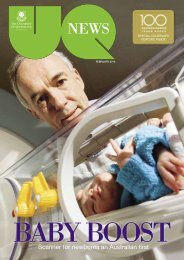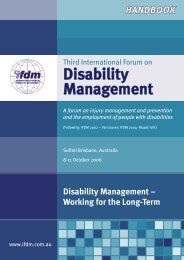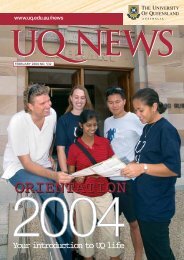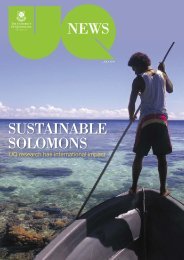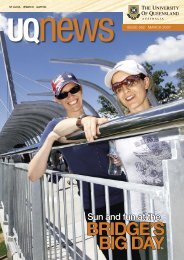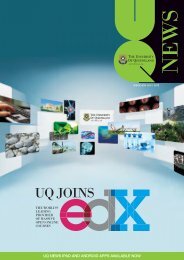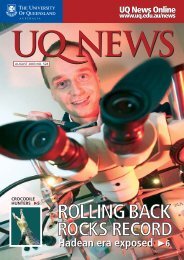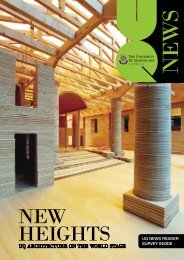01-cover only - Office of Marketing and Communications - University ...
01-cover only - Office of Marketing and Communications - University ...
01-cover only - Office of Marketing and Communications - University ...
You also want an ePaper? Increase the reach of your titles
YUMPU automatically turns print PDFs into web optimized ePapers that Google loves.
Hypersonics jets into 2005The world’s fastest airbreathingengine will flyin Australia next yearthrough a collaborationbetween UQ <strong>and</strong> USdefence organisations.Scramjet engines that could makepossible two-hour flights fromSydney to London have been givena major boost through a new bilateralagreement.Australian <strong>and</strong> US defence interestshave signed a $4.6 million deal toconduct a scramjet experiment at Mach10, or about 11,000km an hour, atWoomera, South Australia, possibly inthe second half <strong>of</strong> 2005.Scramjets are air-breathingsupersonic combustion ramjet enginesthat have the potential to revolutionisethe launch <strong>of</strong> small space payloads,such as communications satellites, bysubstantially lowering costs.Project partners are the USDefence Advanced Research ProjectsAgency (DARPA) <strong>and</strong> the AustralianHypersonics Initiative (AHI).The AHI is represented by UQ;the Defence Science <strong>and</strong> TechnologyOrganisation (DSTO); the <strong>University</strong><strong>of</strong> New South Wales at the AustralianDefence Force Academy; theAustralian National <strong>University</strong>; <strong>and</strong>the governments <strong>of</strong> South Australia<strong>and</strong> Queensl<strong>and</strong>.Pr<strong>of</strong>essor Allan Paull, <strong>of</strong> UQ’sCentre for Hypersonics, is thetechnical leader for the AustralianHypersonics Initiative.He said Australia had establishedan international st<strong>and</strong>ing inhypersonics research.“Australia’s reputation has beenbuilt up over three decades <strong>of</strong> scramjetresearch,” Pr<strong>of</strong>essor Paull said.Dr Warren Harch, Chief <strong>of</strong>DSTO’s Weapons Systems Division,said future defence applications forhypersonic vehicles included longrangereconnaissance <strong>of</strong> potentiallyglobal proportions.Civilian applications includedlow-cost satellite launching <strong>and</strong>high-speed aircraft.Staged Terrier Orion rocket <strong>and</strong> UQpayload on the launchpad at Woomera“Hypersonic propulsion usingsupersonic combustion ramjet(scramjet) technology <strong>of</strong>fers thepossibility <strong>of</strong> high speeds <strong>and</strong> fuelefficiencies that many believe willput numerous defence <strong>and</strong> civilianaerospace applications within ourreach during the next couple <strong>of</strong>decades,” Dr Harch said.UQ’s Deputy Vice-Chancellor(Research) Pr<strong>of</strong>essor David Siddle,said UQ had been at the forefront <strong>of</strong>scramjet technology development.“UQ reported for the first time inthe open literature the development<strong>of</strong> a scramjet that achieved morethrust than drag in ground-testing in1993,” he said.“UQ also led the internationalHyShot program which demonstratedthe world’s first supersoniccombustion in an atmospheric flighttest at Woomera on July 30, 2002, atspeeds <strong>of</strong> more than Mach 8, or eighttimes the speed <strong>of</strong> sound.”Pr<strong>of</strong>essor Siddle said the newcollaboration provided wonderfulopportunities for scientific <strong>and</strong>engineering advances.“The HyShot program wassuccessful because it adopted newapproaches to scramjet flighttesting,”he said.“In particular, HyShot used aflight-path to undertake theexperiment, with a two-stage rocketbooster taking the scramjet payloadto an altitude <strong>of</strong> 315km.”Next year’s experiment will besimilar to HyShot <strong>and</strong> UQ will againlead the flight program, supportedby the AHI’s Canberra node.Pr<strong>of</strong>essor MeekA retired civil engineer from UQhas helped NASA break theworld speed record for anatmospheric engine.On March 28, the spaceagency’s X-43A experimentalaircraft flew at 7700kmh – seventimes the speed <strong>of</strong> sound.Emeritus Pr<strong>of</strong>essor JohnMeek helped verify the aircraftwas strong enough to withst<strong>and</strong>the in-flight vibrations.The 3.7-metre-long planeblasted over the US for 11seconds before plunging intothe Pacific Ocean.The hypersonic plane is across between a jet <strong>and</strong> rocketusing scramjet technology.NASA believes the technologyis capable <strong>of</strong> speeds <strong>of</strong>Mach 10, which will power thenext generation <strong>of</strong> spaceshuttles.Pr<strong>of</strong>essor Meek hasworked closely with Dr KajalGupta from NASA’s DrydenFlight Research Centre, whosecomputer s<strong>of</strong>tware was used toapprove the X-43A test flights.Both men analysed thestrength <strong>of</strong> the aircraft as awhole in its flight environment.Author torally 1960sgraduatesDr Turner HospitalAcclaimed writer <strong>and</strong> UQ graduateJanette Turner Hospital hasbeen chosen as the face <strong>of</strong> thisyear’s <strong>University</strong> <strong>of</strong> Queensl<strong>and</strong>Chancellor’s Fund Appeal.Dr Turner Hospital, who isDistinguished Pr<strong>of</strong>essor <strong>of</strong> English atthe <strong>University</strong> <strong>of</strong> South Carolina(USC), teaches a free undergraduatecourse in contemporary literature sopopular that it attracts registrationsfrom 600 members <strong>of</strong> the public.When USC ran out <strong>of</strong> sufficientfunds to <strong>of</strong>fer the course, such was theenthusiasm <strong>of</strong> the students they b<strong>and</strong>edtogether <strong>and</strong> raised US$20,000 in justa few weeks to keep it going.Dr Turner Hospital said she hopedto tap into a similar spirit <strong>of</strong> giving toraise funds for UQ programs <strong>and</strong>infrastructure.With the 2004 appeal focused onfellow graduates <strong>of</strong> the 1960s, she saidshe was convinced <strong>of</strong> the need fordynamic cross-fertilisation <strong>of</strong> ideas<strong>and</strong> interactions between community<strong>and</strong> <strong>University</strong>, “town” <strong>and</strong> “gown”.“An important way <strong>of</strong> achievingthis end is through donations toappeals such as this,” she said.Dr Turner Hospital urged allgraduates, especially those from the1960s, to give generously to this year’sAppeal.She said if graduates gave aminimum <strong>of</strong> $60 each, the target <strong>of</strong>$600,000 would be readily achieved.“I look back with fond memories<strong>of</strong> my own time at <strong>University</strong> – theactivities I was involved in, the friendsI made <strong>and</strong> the intellectual stimulation<strong>of</strong> those heady days,” she said.“But things have changed dramaticallysince the 1960s. Universitiesaround the world have had to relyincreasingly on donations in order toprovide not just the educational extras,but in some cases, the basics.”UQ Deputy Vice-Chancellor(International <strong>and</strong> Development),Pr<strong>of</strong>essor Trevor Grigg, said he hoped1960s graduates would dig deep fortoday’s pressured university sector.“The 1960s was a time whenuniversity students everywhereheightened their senses <strong>of</strong> socialresponsibility, optimism <strong>and</strong> globalunderst<strong>and</strong>ing,” Pr<strong>of</strong>essor Grigg said.“Today, it’s a very differentenvironment students find themselvesin. A decade <strong>of</strong> government fundingcutbacks <strong>and</strong> ‘making do’ is taking itstoll <strong>and</strong> the gains <strong>of</strong> the past mayevaporate if sufficient funds are notfound.”Information: Margaret Burke(telephone 07 3346 3902, emailmargaret.burke@uq.edu.au)4 UQ NEWS, june 2004



